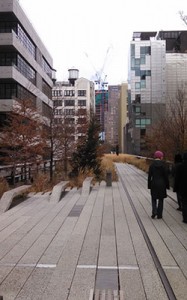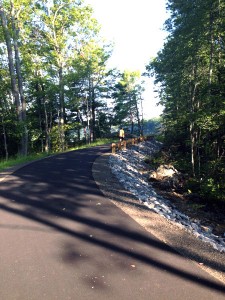In a previous post on this blog, we discussed the economic challenges and opportunities raised by public investments in infrastructure. In some cases, such as a new or renovated bridge, it is clear how the public benefits from infrastructure—convenience, safety, a means from here to there. In other instances, such as a new park, the public benefit is less apparent.
People tend to think of parks, sidewalks, and walking and biking trails as a nice quality-of-life enhancement to a community, but there are economic benefits gained from this kind of infrastructure. Consider the case of Chattanooga, Tennessee. In the early 1980s, the city was in a deep recession and unemployment, pollution, and flight to the suburbs led to a lower quality of life downtown. According to a report from the Trust for Public Land (TPL), the acquisition of open space and the construction of parks and trails have directly led to an economic revival downtown. Following a public and private investment of $356 million in the downtown riverfront, between 1988 and 1996, “the number of businesses and full-time jobs more than doubled, and assessed property values went up over $11 million, an increase of 127.5 percent.” More important for city planners, the annual combined city and property tax revenues for the area increased 99 percent.
There is a strong case to be made that the economic benefits realized from more open and pedestrian-friendly space in Chattanooga can be replicated elsewhere.
Bicycle-friendly and walkable cities and towns see increased property values and greater economic activity
According to the Wall Street Journal, walkable suburbs have “greater economic output and higher incomes, more highly educated people, and more high-tech industries.” A report from an organization called CEOs for Cities found that residential real estate prices increase in communities that are walk and bike friendly, which in turn increases property tax revenue. Homebuyers are willing to pay an average $20,000 to $34,000 more for homes in pedestrian-friendly communities. Walk Boston cited a 2010 study from the University of Arizona and Indiana University that found a 10-point increase in Walk Score increased commercial property values by five to eight percent. And according to the Urban Land Institute (ULI), shoppers in walkable retail areas visit more often, stay longer, and spend more money.
Bicycling supports the economy in much the same way as walkability. AARP cited a report by the League of American Bicyclists (LAB) that included case studies where bike-friendly urban areas contributed to a boost in economic activity and an increase in tourism. A New York City Department of Transportation study found a 49% increase in retail sales on a street where a protected bike lane was created. A bike lane might cost about $5,000 a mile, but the return can be significant. For example, according to a report cited by the LAB, North Carolina spent $6.7 million on bicycle infrastructure in the Outer Banks area, and the report conservatively estimated an annual nine to one return on that one-time investment.
Furthermore, the ULI cited a 2011 study, undertaken by the Political Economy Research center at the University of Massachusetts at Amherst, that estimated for every $1 million spent on the construction of bicycle- and pedestrian-friendly facilities 11.41 jobs were created for bicycle infrastructure and 9.91 jobs for pedestrian infrastructure. And Fast Company reported: “For every dollar spent to build new separated bike lanes, cities could save as much as $24 thanks to lower health care costs and less pollution and traffic, according to a new study from researchers in New Zealand.”
Trails also draw visitors. Woodard & Curran worked with the Town of Lisbon to expand and improve the Lisbon Trails System. In 2013, 50,000 people used the trails, many from other cities or states. Adding the new Androscoggin River Trail to this system was important to Lisbon, not only because it draws visitors, but because it restored a connection to the Androscoggin River—a central component of the town’s and region’s cultural and environmental history.
Hiking trails and greenways create a positive economic impact as well, according to the organization American Trails. For example, a trail system in Orange County, Florida contributed to 516 jobs and an estimated economic impact of $42.6 million in 2010. An American Hiking Society (AHS) fact sheet noted that equipment purchased for use on trails also creates a positive economic impact. The AHS cites the Washington State Trails Plan, which estimated that trail users purchased $3.4 billion in equipment, generating tax revenues of $13.8 to $27.6 million.
Parks also contribute to local economic gains

High Line park
American Trails cited a pair of studies conducted in 2000 and 2001 that analyzed the same set of more than 16,400 home sales in Portland, Oregon and found, “the existence of a park within 1,500 feet of a home increased its sale price by between $845 and $2,262 (in 2000 dollars). Additionally, as parks increased in size, their impact on property value increased significantly.”
The increase in property value, again, provides an increase in property tax capture. The TPL studied the “hedonic value” (i.e. the value appropriated to a home near something that is perceived as pleasant) of living near a park. The study estimated a five percent increase in property value could be attributed to living within 500 feet of a park. For homes in Washington D.C. this would amount to more than $6 million in additional property tax.
Like trails, parks also drive economic activity. Earlier this winter, my wife and I were joined by friends in New York City, and we walked the High Line on the west side of Manhattan, a public park on an abandoned elevated freight line (see images on the right and at the top of this post). In 2011 and prior to the start of construction of the last segment of the project, with total public investment of roughly $150M, the Mayor’s Office reported an estimated $2 billion in private investment adjacent to the High Line. The economic development activity around this public park is incredible; we observed real estate listings for new 1 to 3 bedroom condominiums with sales prices ranging from $5 to $10 million.
Open space provides environmental benefits with economic value
Studies conducted by the TPL have shown that “conservation returns from $4 to $10 for every dollar invested. It also provides recreational opportunities, controls flooding, and protects air and drinking water quality, wildlife habitat, and farms while supporting industries such as tourism, agriculture, and fisheries.”
The TPL noted that another Woodard & Curran client in Auburn, Maine, saved $30 million in capital costs, and an additional $750,000 in annual operating costs, by spending $570,000 to acquire land in their watershed in order to maintain water quality standards and avoid building a new filtration plant.
Forests also have value in protecting drinking water sources. A study conducted by the TPL and the American Water Works Association found that for “every 10 percent increase in forest cover in the source area, treatment and chemical costs decreased approximately 20 percent, up to about 60 percent forest cover.”
Even urban trees have value. Trees cover 27 percent of the City of Atlanta, Georgia. The TPL estimates that the City’s trees save $883 million in avoided stormwater treatment costs.
The economic factors shared here do not include the additional indirect benefit of better health for bicyclists and walkers as well as the aesthetic benefits of better parks, sidewalks, hiking trails, and bicycle paths. Still, it is apparent that significant economic benefits are derived through the development of the kinds of infrastructure described above.
Read Part I of this series on the blog, which makes the case for overall infrastructure investment and Part III, which details the benefits of investing in water and wastewater treatment facilities.

